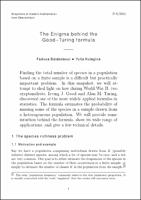| dc.contributor.author | Balabdaoui, Fadoua | |
| dc.contributor.author | Kulagina, Yulia | |
| dc.contributor.editor | Singh, Anup Anand | |
| dc.contributor.editor | Munday, Sara | |
| dc.contributor.editor | Jahns, Sophia | |
| dc.date.accessioned | 2021-07-16T13:45:28Z | |
| dc.date.available | 2021-07-16T13:45:28Z | |
| dc.date.issued | 2021-07-16 | |
| dc.identifier.uri | http://publications.mfo.de/handle/mfo/3875 | |
| dc.description.abstract | Finding the total number of species in a population
based on a finite sample is a difficult but practically
important problem. In this snapshot, we will attempt
to shed light on how during World War II, two
cryptanalysts, Irving J. Good and Alan M. Turing,
discovered one of the most widely applied formulas in
statistics. The formula estimates the probability of
missing some of the species in a sample drawn from
a heterogeneous population. We will provide some
intuition behind the formula, show its wide range of
applications, and give a few technical details. | en_US |
| dc.language.iso | en | en_US |
| dc.publisher | Mathematisches Forschungsinstitut Oberwolfach | en_US |
| dc.relation.ispartofseries | Snapshots of modern mathematics from Oberwolfach;2021-08 | |
| dc.rights | Attribution-NonCommercial-ShareAlike 4.0 International | * |
| dc.rights.uri | http://creativecommons.org/licenses/by-nc-sa/4.0/ | * |
| dc.title | The Enigma behind the Good–Turing formula | en_US |
| dc.type | Article | en_US |
| dc.identifier.doi | 10.14760/SNAP-2021-008-EN | |
| local.series.id | SNAP-2021-008-EN | en_US |
| local.subject.snapshot | Probability Theory and Statistics | en_US |
| dc.identifier.urn | urn:nbn:de:101:1-2021072012264249531220 | |
| dc.identifier.ppn | 1763982572 | |


